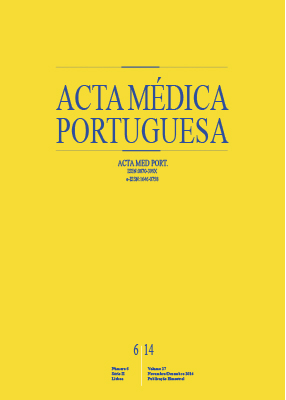Laparoscopic Cholecystectomy and Open Cholecystectomy in Acute Cholecystitis: Critical Analysis of 520 Cases
DOI:
https://doi.org/10.20344/amp.5258Abstract
Introduction: Despite the skepticism with which it was initially seen, laparoscopic cholecystectomy is now the technique of choice for acute cholecystitis. It is, however, important to evaluate the results in comparison with classic cholecystectomy, since the latter is still used by some surgeons in certain situations.Material and Methods: Our research corresponds to the analysis of 520 patients operated on for acute cholecystitis performed in the department of surgery at the São João Hospital in Oporto - 412 (79.2%) laparoscopic cholecystectomies and 108 (20.8%) open cholecystectomies - from 2007 to 2013. We evaluated comorbidities, leukocytosis, time between diagnosis and surgery, ASA, per and postoperative complications, mortality, reoperations, lesion of main bile duct, conversion rate and hospital stay, in order to compare these two techniques. The conversion group was included in laparoscopic cholecystectomy. Statistical analysis was based on descriptive statistic procedures and the evaluation of contrast between groups was based on Fishers’ exact test. Significant values were considered for p < 0.05.
Results: Laparoscopic Cholecystectomy versus Open Cholecystectomy: Mortality: 0.7% vs 3,7% (p = 0.0369); Peroperative complications: 3.6% vs 12.9% (p = 0.0006); Surgical postoperative complications: 7.7% vs 17.5% (p = 0.0055); Medical postoperative complications: 4.3% vs 5.5% (p = 0.6077); Lesion of the main bile duct: 0.9% vs 1.8% (p = 0.6091); Reoperation: 2.9% vs 5.5% (p = 0.2315); Hospital stay up to 4 days after surgery: 64.8% vs 18.5% (p < 0.001). The convertion rate was of 10.7%: 8.8% in early surgery (before 4 days after de diagnosis) and 13.7% in the late surgery (after this time but in the same stay) (p = 0.1425). Multiple causes led to convertion: surgical complications (biliary lesions, iatrogenic lesion of the small bowel, perfurations of the gallbladder with spillage of stones); complications during the pneumoperitoneum, unclear anatomy and scoliosis. Postoperative complications in laparoscopic cholecystectomies converted group vs non-converted: surgical 20.4% vs 6.2% (p = 0.0034) and medical 6.8% vs 4.1% (p = 0.4484).
Discussion: There are few investigations concerning the comparison of laparoscopic cholecystectomy vs acute cholecystitis in patients with acute cholecystitis, corresponding mostly to multicenter studies. For this reason, we carry out an analysis inherent to 520 patients operated on with that disease in the surgery department of Hospital S. João in Oporto of which 412 were by laparoscopic cholecystectomy and 108 by acute cholecystitis. We found better results in laparoscopic cholecystectomy than in acute cholecystitis with respect to mortality, per and post-operative surgical complications and hospital stay. The incidence of main bile duct injury, medical
complications and reoperations, although less evident in laparoscopic cholecystectomy, were not statistically significant. There were more complications in the group of laparoscopic cholecystectomy converted than in those where it was not be necessary the conversion. This raises the need, in complications during the laparoscopic cholecystectomy, not to perform the conversion too late. The analysis of this study, therefore, properly values laparoscopic cholecystectomy in the surgery of patients with acute cholecystitis.
Conclusion: The results justify the frequency with which laparoscopic cholecystectomy is performed in acute cholecystitis, in comparison to open surgery, thus taking an increasingly prominent place in the treatment of this disease.
Keywords: Cholecystectomy, Laparoscopic; Cholecystectomy; Cholecystitis.
Downloads
Downloads
Published
How to Cite
Issue
Section
License
All the articles published in the AMP are open access and comply with the requirements of funding agencies or academic institutions. The AMP is governed by the terms of the Creative Commons ‘Attribution – Non-Commercial Use - (CC-BY-NC)’ license, regarding the use by third parties.
It is the author’s responsibility to obtain approval for the reproduction of figures, tables, etc. from other publications.
Upon acceptance of an article for publication, the authors will be asked to complete the ICMJE “Copyright Liability and Copyright Sharing Statement “(http://www.actamedicaportuguesa.com/info/AMP-NormasPublicacao.pdf) and the “Declaration of Potential Conflicts of Interest” (http:// www.icmje.org/conflicts-of-interest). An e-mail will be sent to the corresponding author to acknowledge receipt of the manuscript.
After publication, the authors are authorised to make their articles available in repositories of their institutions of origin, as long as they always mention where they were published and according to the Creative Commons license.









